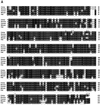Mechanism of cell entry and transformation by enzootic nasal tumor virus
- PMID: 11836391
- PMCID: PMC153819
- DOI: 10.1128/jvi.76.5.2141-2149.2002
Mechanism of cell entry and transformation by enzootic nasal tumor virus
Abstract
Enzootic nasal tumor virus (ENTV) induces nasal epithelial cancer in infected sheep, but it is a simple retrovirus lacking a known oncogene. ENTV is closely related to jaagsiekte sheep retrovirus (JSRV), which also causes cancer in sheep but in the epithelial cells of the lower airways and alveoli. Here we show that as with JSRV, the envelope (Env) protein of ENTV can transform cultured cells and thus is likely to be responsible for oncogenesis in animals. In addition, the ENTV Env protein mediates virus entry using the same receptor as does JSRV Env, the candidate tumor suppressor Hyal2. However, ENTV Env mediates entry into cells from a more restricted range of species than does JSRV, and based on this finding we have identified amino acid regions in the Env proteins that are important for virus entry. Also, because ENTV does not efficiently use human Hyal2 as a receptor, we cloned the ovine Hyal2 cDNA and show that the encoded protein functions as an efficient receptor for both ENTV and JSRV. In summary, although ENTV and JSRV use the same cell surface receptor for cell entry and apparently transform cells by the same mechanism, they induce cancer in different tissues of infected sheep, indicating that oncogenesis is regulated at some other level. The transcriptional regulatory elements in these viruses are quite different, indicating that tissue-specific oncogenesis is likely regulated at the level of viral gene expression.
Figures







References
-
- Alian, A., D. Sela-Donenfeld, A. Panet, and A. Eldor. 2000. Avian hemangioma retrovirus induces cell proliferation via the envelope (env) gene. Virology 276:161-168. - PubMed
-
- Coffin, J. M. 1996. Retroviridae: the viruses and their replication, p. 1767-1847. In B. N. Fields, D. M. Knipe, and P. M. Howley (ed.), Fields virology. Lippincott-Raven, Philadelphia, Pa.
-
- Cross, S. L., M. B. Feinberg, J. B. Wolf, N. J. Holbrook, F. Wong-Staal, and W. J. Leonard. 1987. Regulation of the human interleukin-2 receptor alpha chain promoter: activation of a nonfunctional promoter by the transactivator gene of HTLV-I. Cell 49:47-56. - PubMed
Publication types
MeSH terms
Substances
Grants and funding
LinkOut - more resources
Full Text Sources
Other Literature Sources
Medical
Molecular Biology Databases

